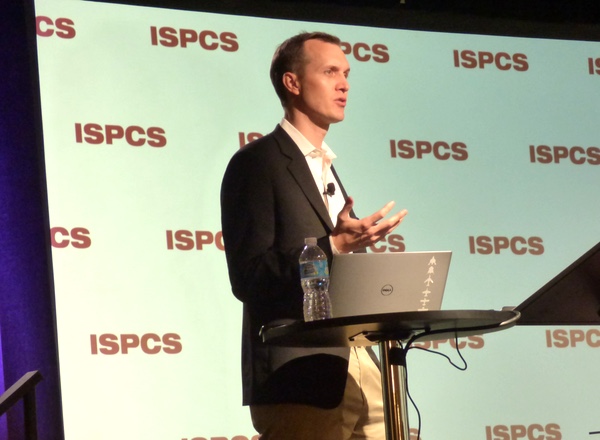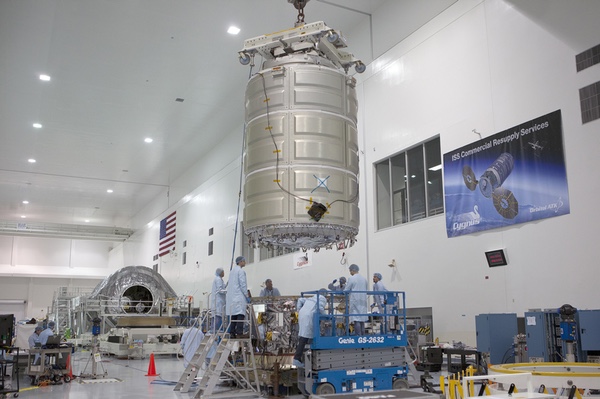Looking back a year and a decadeby Jeff Foust
|
| “Orbital and SpaceX have done a great job managing their investigations,” said FAA’s Romanowski. “They’re in their final wrap-up phases and approaching the closeout and evaluation phase.” |
A year later, many questions about the accidents, and the industry in general, remain open. Investigations into both accidents have wound down, although some details have not been, and may never be, released. Both companies are working to return to flight with new and improved vehicles, but still face challenges. And the accidents, and the slow pace in some areas of broader industry, make people wonder how real and sustainable this field really is.
Returning to flight, one year later
It was clear in the weeks after the Antares failure that the accident was caused by a problem with one of the AJ26 engines—“Americanized” version of Soviet-era NK-33 engines—that powered the rocket’s first stage. The company said not long after the accident that a malfunction in the turbopump led to the failure of the engine and thus the launch vehicle, but there have been debates about whether the problem was a flaw in the engine itself or elsewhere in the vehicle: a key point on whether the company at fault was Orbital or Aerojet Rocketdyne, which provided the AJ26 engine.
Neither company has disclosed much additional information about the accident investigation. However, Aerojet announced last month that it paid $50 million to Orbital ATK to end the dispute between the companies about who was at fault and to terminate Aerojet’s contract to supply engines.
Aerojet spokesman Glenn Mahone said last month that the investigations into the failure were completed and submitted to both NASA and the FAA, but that there was little the companies could say about them. “Virtually all of the data are highly proprietary, and there is nothing meaningful we can disclose,” he said.
At a meeting of the FAA’s Commercial Space Transportation Committee (COMSTAC) last week in Washington, the agency confirmed that the investigation into the accident was wrapping up. “Orbital and SpaceX have done a great job managing their investigations,” said Michael Romanowski of the FAA’s Office of Commercial Space Transportation, referring to both the Antares failure and June’s Falcon 9 failure. “They’re in their final wrap-up phases and approaching the closeout and evaluation phase.” He did not offer any specific details about the findings of the investigation, though.
Orbital is pressing ahead with separate returns to flight for its Cygnus cargo spacecraft and its Antares launch vehicle. A Cygnus is currently at the Kennedy Space Center being loaded with cargo for launch on a United Launch Alliance Atlas V on December 3. A second Cygnus/Atlas launch is scheduled for March.
Antares, meanwhile, is being prepared for its return to flight, sporting an RD-181 engine in place of the discontinued AJ26. Orbital officials said early last month the Antares could be ready for flight as soon as March, but with Cygnus flying on Atlas that month, that launch will be delayed.
“They are prepping for a hot-fire test early next year, and then our first mission on Antares will be later in the first half of the year, most likely May,” said Frank DeMauro, a vice president in Orbital ATK’s Space Systems Group, at the International Symposium for Personal and Commercial Spaceflight (ISPCS) earlier this month in Las Cruces, New Mexico.
| “We’re getting very close now, making great progress. But I don’t want to put undue pressure on them by giving them an artificial timeline,” Whitesides said SpaceShipTwo’s schedule. |
By contrast, much more is known about the SpaceShipTwo accident, thanks to a National Transportation Safety Board (NTSB) investigation that concluded in July (see “A failure of foresight and oversight”, The Space Review, August 3, 2015.) That investigation largely exonerated the overall design of the suborbital vehicle itself, concluding that Alsbury, the co-pilot, prematurely unlocked the vehicle’s feathering system because developers never envisioned a pilot doing that, and never put in safeguards to prevent it from happening.
“The airframe itself, we think, is sound. The propulsion system is sound,” said George Whitesides, CEO of Virgin Galactic, at ISPCS. “We required very few changes to the vehicle following our test flight accident.”
Virgin is currently completing the second SpaceShipTwo, and at ISPCS Whitesides ticked off some recent milestones, like a fit check of the vehicle’s oxidizer tank and the completion new seats for pilots in the vehicle’s cockpit. However, he declined to give a schedule for when test flights of SpaceShipTwo might resume.
“We’ll resume flights when we’re ready to do so,” he said. “We’re getting very close now, making great progress. But I don’t want to put undue pressure on them by giving them an artificial timeline.” Whitesides and others had previously suggested those test flights could begin later this year.
One change for the vehicle is another switch in fuels. Whitesides said the company has been testing a rubbed-based fuel, hydroxyl-terminated polybutadiene (HTPB), in a series of static-fire demonstrations, with promising results. “I’m pleased to say that we have had really terrific progress” on the vehicle’s propulsion system, he said while showing videos of two recent engine tests, each running about 60 seconds. “We have good combustion quality on these firings.”
Whitesides later indicated that, if a series of qualification test firings go as planned, Virgin will baseline the use of the HTPB-fueled motor for SpaceShipTwo’s later powered test flights. That would be a reversal of a decision it made last year, when Virgin said it was switching from HTPB to a polyamide, or nylon, fuel because of better performance. That engine was used on last October’s test flight, but was not implicated in the failure.
The FAA, meanwhile, is preparing its response to the NTSB report, which included a series of recommendations for the office. “We are coming on to final closure on our initial response,” said Romanowski at the COMSTAC meeting, noting that the response was due 90 days after the report’s release in early August. “We’re in the final coordination with the [FAA] administrator on the response.”
 Virgin Galactic CEO George Whitesides said his company was recovering from last year’s accident, but declined to say when test flights would resume. (credit: J. Foust) |
Bouncing back and looking back
Both Orbital and Virgin said at ISPCS they were moving past last year’s accidents and focusing on their return-to-flight activities. “We gave ourselves a little bit of time—a couple of hours—to lick our wounds,” DeMauro said. “But the following day, the company embarked on figuring out how we were going to return to flight.”
“The accident was a tough blow for Galactic, but it was one that will not define the company,” Whitesides said. “It is one that we must move past and that we are moving past with determination and with spirit.”
| “You have to be resourceful and resilient,” Spaceport America’s Anderson said. |
There was, though, some sense of reflection about the past year, and even the past decade, at the conference. “While our industry has suffered some technical setbacks, there are no shutdowns for us,” said conference organizer Pat Hynes, an allusion to a barely-averted government shutdown that threatened, as was the case in 2013, to put a damper on the conference. “These companies are still working, they’re still moving forward, and we will be better off in the future.”
This year was also the tenth anniversary of ISPCS. The conference, originally named the International Symposium for Personal Spaceflight, started in 2005 as an event leading up to the Countdown to the X PRIZE Cup in Las Cruces, an air and space show intended to be a forerunner of a future X PRIZE Cup that would pit suborbital vehicles against one another in a series of competitions drawing upon the air races that were popular in the early 20th century (see “A day at the space show”, The Space Review, October 11, 2005).
The X PRIZE Cup fizzled, though, in part because the wave of suborbital vehicles expected to enter service after SpaceShipOne won the $10-million Ansari X PRIZE in 2004 never materialized. Most of the teams competing in the competition faded away after SpaceShipOne’s victory, depriving the cup of its roster of competitors.
One of the few original Ansari X PRIZE competitors to survive is ARCA Space. Originally started as a non-profit organization in Romania, ARCA incorporated as a for-profit company in the US in 2014, setting up shop in Las Cruces. ARCA is working on an unmanned aerial vehicle called AirStrato, but has not given up on its effort to build a crewed suborbital vehicle.
“We understood that the only way to have a space company is to finance it yourself until it is profitable. Not with sponsors, and not with governmental contracts,” said Dumitru Popescu, president of ARCA Space, at ISPCS. ARCA’s work on AirStrato, he said, will serve as a “financial backbone” to support work on its later suborbital vehicle.
The X PRIZE Cup lasted until 2007, and in 2008 the X PRIZE Foundation held flight demonstrations for the Northrop Grumman Lunar Lander Challenge prize competition, part of NASA’s Centennial Challenges program, in Las Cruces right after ISPCS. Later, the conference tied itself to the development of Spaceport America, with dedication ceremonies for the spaceport’s runway and main terminal building timed to coincide with ISPCS. Now, with the spaceport waiting out extended delays in operations by its anchor tenant, Virgin Galactic, the conference is standing on its own.
Spaceport America itself was not a major topic of discussion at the conference, even as the spaceport continues its efforts to diversity its customer base while waiting for Virgin to begin operations there. In a phone interview, Christine Anderson, executive director of the New Mexico Spaceport Authority, said her office was working on bringing in new users for the spaceport, ranging from ARCA Space—which plans to test its UAVs and, later, suborbital vehicles at the spaceport—to satellite ground stations and tourism.
| “We as an industry and we, certainly, as a company have been predicted to die every year in the 11 years that I have been doing this,” Sirangelo said. “And, so far, I’m still standing up here on this stage.” |
Even with those efforts, Anderson said it will be no sooner than late 2017 or early 2018 before she expects the spaceport to be financially self-sufficient, and thus no longer rely on funding from the state to support operations. That would be timed to the start of commercial flights by Virgin Galactic, and possibly the use of the spaceport by SpaceX to test reusable launch vehicle technology, an effort put on hold by the June Falcon 9 failure.
The spaceport, though, is taking those setbacks in stride as it seeks other business. “You have to be resourceful and resilient,” she said.
That’s good advice for any industry that, in some areas, is taking longer to develop than what many expected at the first ISPCS a decade ago. At this year’s conference, one of the speakers was Mark Sirangelo of Sierra Nevada, who said his company was still committed to developing its Dream Chaser vehicle even if the company loses the upcoming NASA commercial cargo competition. NASA is expected to award two or more contracts for cargo services on or about November 5.
“We as an industry and we, certainly, as a company have been predicted to die every year in the 11 years that I have been doing this,” he said during a press conference held at the conference. “And, so far, I’m still standing up here on this stage.”
